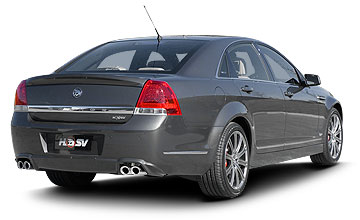BY BYRON MATHIOUDAKIS | 25th May 2007

In a nutshell, while miles better than any previous big Holden, the Caprice does not seem to have quite the same impressive tautness of body control, while the car pitches a little over some road surfaces for a less stable and smooth ride than its shorter-wheelbase stablemate.
It is enough to undermine a luxury sedan that is otherwise a compelling mix of modernity, space, value, V8 performance and size.
But if you are used to any of the last two generations of BMW 7 Series, Mercedes S-class or Audi A8, the Caprice still behaves more like a jumped-up Commodore than a cut-price sports saloon.
That would be that, except for the fact that Holden Special Vehicles has attacked the Statesman/Caprice duo’s shortcomings on two fronts with its version of the WM long-wheelbase cars, the Grange.
Firstly, it employs the Delphi-developed Magnetic Ride Control damper device that instantaneously adjusts pressures to suit road and driver-input conditions via several sensors around the vehicle.
Small but noticeable differences in the car’s handling and cornering attitude can be detected when pushing on.
Just as importantly, the Grange’s ride quality seems calmer and more settled than on its Holden-badged cousin.
The overall effect is a big step in the right direction.
Grange drivers can more ably explore the big American 6.0-litre V8’s mega power and torque reserves, thanks to its ability to better carve-up corners while doing a more successful job cosseting its occupants from unwanted and sudden movements.
Why Holden has not adapted this technology for the Statesman and Caprice is a mystery.
The Grange’s interior is slightly sportier in presentation than its donor car, with three extra binnacles perched in the centre, bespoke instrumentation graphics and illumination, and minor trim and material differences to spell the more athletic nature of this car.
It is much more tasteful than you might imagine, and the result is dependent on the beholder. We believe the target audience will lap it up, particularly if they are coming from Commodore SS and the like. Others might find the additions unnecessary and tackier than the WM Caprice’s.
Grange’s exterior alterations are far better executed than we expected.
Still, the Grange does not completely exorcise some of the Caprice’s other shortcomings – namely, untoward wind and road noise, and the odd cabin rattle and squeak.
The V8 may have a king-of-the-jungle exhaust rumble that matches the unrelenting forward thrust that accompanies it, but the six-speed automatic gearbox that feed it to the rear wheels has a few grumbles of its own.
As with the other Holden-badged models using this drivetrain combination, there are issues of smoothness and response.
This GM-derived gearbox can be slow to react and does not change up as happily in certain situations, such as after a spell of hard driving.
HSV says that driver-adaptive software ‘determines’ changes, and so may be slow to settle down again, but even during gentle driving periods, the same criticisms have applied.
Blue-collar image aside, this transmission malady is perhaps the Grange’s biggest hurdle in truly being an Audi S8 rival at a fraction of the funds, but the fact that the HSV gets close is great news for Australians.
There is a gaping hole in the market for a car of this performance, luxury, size and value, and we should be grateful that it exists. It would only take a little more polish for the Grange to give the Europeans and Japanese something really serious to think about.
Although they are remarkably similar, the items that make the HSV unique under the skin are also what make it better than the Caprice V8 to ride in and drive.
VE Calais owners now have something in the HSV stable to trade up to without feeling that they are moving down.